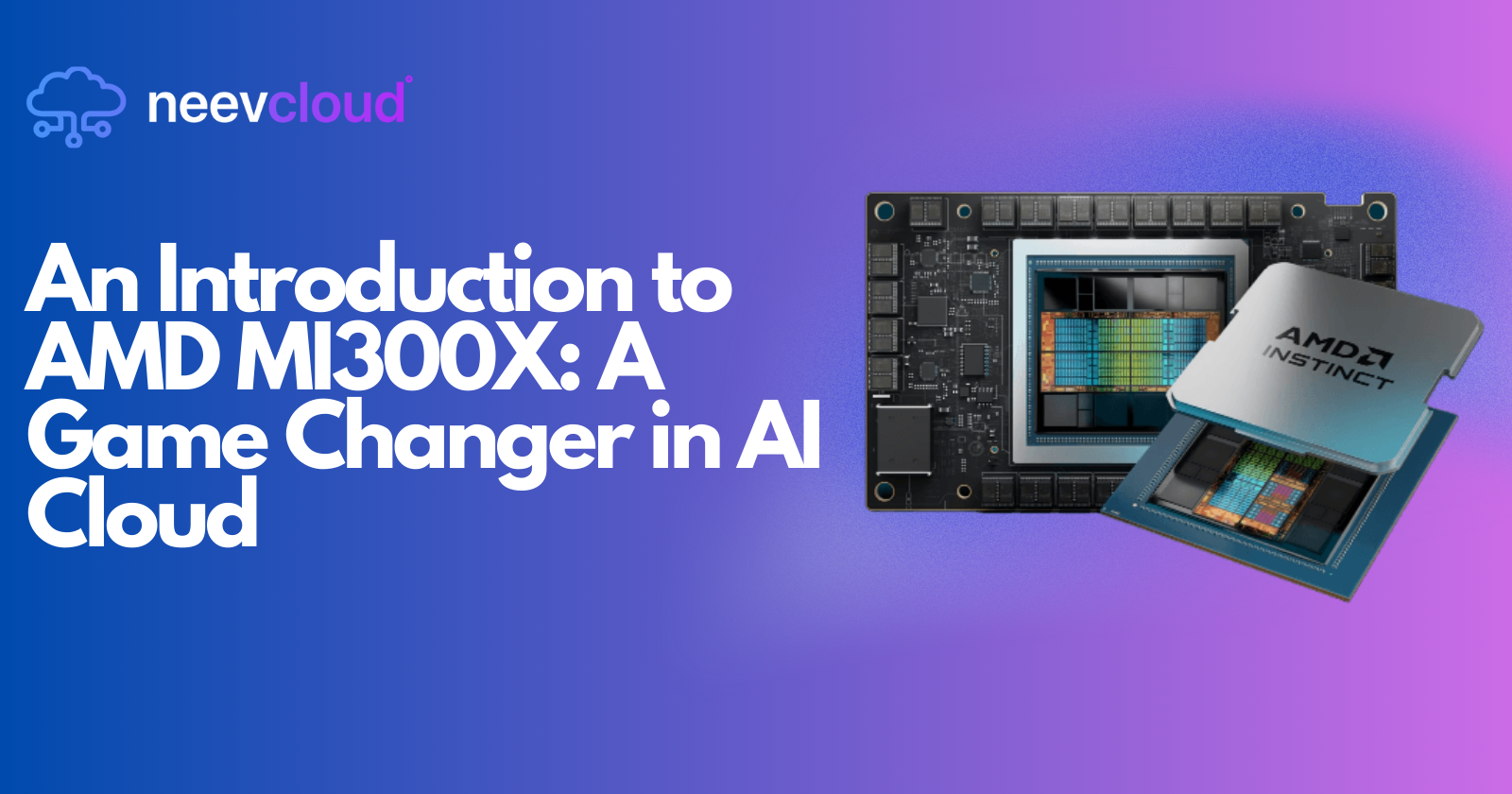An Introduction to AMD MI300X: A Game Changer in AI Cloud
 Tanvi Ausare
Tanvi Ausare
As the demand for high-performance computing (HPC) and artificial intelligence (AI) workloads skyrockets, the race among hardware providers has become more intense. AMD's latest product, the MI300X GPU, is a shining contender. Designed to challenge NVIDIA’s H100 and upcoming H200, the MI300X is tailor-made for AI workloads running in AI Cloud environments and GPU clusters. This blog explores how AMD’s latest innovation can transform AI infrastructure, offering insights into its architecture, performance benchmarks, and competitive edge.
The Need for Advanced GPUs in AI Cloud
AI Cloud environments rely heavily on GPU clusters to accelerate complex neural network training, data analytics, and model inference. With large language models (LLMs) such as GPT and multimodal models like DALL·E becoming more prevalent, the hardware backing them needs to be robust, scalable, and efficient.
While NVIDIA’s H100 has dominated the market, developers and enterprises have been eagerly waiting for AMD’s answer—enter the MI300X. AMD’s latest innovation is optimized to handle large-scale AI workloads, making it a compelling choice for enterprises looking to build efficient GPU clusters.
What Is the AMD MI300X?
The AMD MI300X is a cutting-edge GPU accelerator aimed at accelerating AI workloads in cloud environments. AMD MI300X is a powerful accelerator optimized for scaling AI inference workloads. Its performance revolutionizes AI cloud computing. It is part of AMD’s broader Instinct MI300 series, which is a blend of both GPU and APU technologies, providing versatility for various computational tasks.
This model builds on AMD’s experience from the MI200 series and introduces significant improvements in areas like memory bandwidth, energy efficiency, and large-scale parallelism.
Here are the key highlights of the MI300X:
128 GB of HBM3 memory: Ideal for massive datasets and large language models.
Advanced chiplet architecture: Improves manufacturing yields and performance scaling.
AI-specific optimizations: Supports tensor operations critical for deep learning workloads.
Compatibility with open-source frameworks: Allows seamless integration with popular AI libraries.
The MI300X GPU is specifically designed to accelerate large-scale models—especially where memory-intensive operations are a bottleneck—delivering unprecedented performance in GPU clusters optimized for the AI Cloud.
The Architecture of MI300X: A New Era of Modular Design
The chiplet-based architecture of the MI300X marks a major innovation. Instead of a traditional monolithic GPU, the MI300X uses a 3D-stacked chiplet design, combining CPU and GPU cores with high-bandwidth memory (HBM3). This design allows for:
Increased yields and reduced manufacturing costs: Individual chiplets can be produced separately and integrated later.
Greater flexibility for AI workloads: CPU-GPU integration enhances the ability to manage various types of data streams efficiently.
Thermal efficiency: Optimized chip layout improves cooling, reducing energy usage.
This modular architecture offers significant advantages in scalability and performance, making the MI300X ideal for building GPU clusters for AI cloud platforms.
Use Cases: Where AMD MI300X Shines
1. Training Large Language Models
The AMD MI300X’s large memory and bandwidth allow it to handle transformer-based models efficiently. Models like GPT-4, LLaMA, and others can be trained on the MI300X without running into memory limitations that plague smaller GPUs.
2. Inference at Scale in AI Cloud Environments
Deploying inference pipelines on GPU clusters is one of the core use cases in AI Cloud. Thanks to the MI300X’s AI optimizations, enterprises can achieve faster inference for tasks like real-time chatbots, recommendation systems, and image generation applications.
3. Scientific Computing and HPC
Beyond AI, the MI300X is ideal for high-performance computing tasks such as climate modeling, genomics, and fluid dynamics simulations. Its chiplet architecture allows it to handle both AI and traditional HPC workloads efficiently.
GPU Clusters and the Role of AMD MI300X in AI Cloud
The true potential of the MI300X can be unlocked when deployed in GPU clusters—sets of interconnected GPUs working in tandem. These clusters form the backbone of modern AI Cloud platforms, which run a range of services, including LLM training, AI model inference, and generative AI applications.
AMD’s MI300X has several advantages for GPU clusters:
Scalable architecture: AMD’s chiplet design makes it easier to integrate multiple GPUs into a cluster.
Improved interconnect bandwidth: Faster communication between GPUs in a cluster reduces bottlenecks.
Open-source support: The MI300X works seamlessly with ROCm, AMD’s open-source GPU computing platform, making it a developer-friendly option.
Challenges and Opportunities: Can AMD Overtake NVIDIA?
While the MI300X is a powerful GPU, AMD faces several challenges in penetrating a market largely dominated by NVIDIA. NVIDIA’s CUDA ecosystem has become the standard for many AI workloads, giving it a significant advantage. However, AMD’s ROCm platform is rapidly evolving and gaining adoption, especially among cloud providers and open-source communities.
Another challenge is the network effect. Many enterprises are already locked into NVIDIA’s ecosystem, making it difficult for AMD to convince them to switch. However, the combination of cost efficiency, high memory capacity, and performance scaling gives AMD a strong value proposition.
The future will likely see hybrid GPU clusters where both NVIDIA H100/H200 and AMD MI300X are deployed side by side. This mixed environment will allow enterprises to leverage the strengths of both architectures, driving innovation in AI and HPC.
Conclusion
The AMD MI300X is a significant step forward for AMD, offering a compelling alternative to NVIDIA’s H100 in AI Cloud and GPU clusters. With 128 GB of HBM3 memory, advanced parallelism, and improved energy efficiency, the MI300X is well-positioned to handle next-generation AI workloads.
For enterprises building AI infrastructure, the MI300X offers an exciting new option that balances performance, scalability, and cost. As AI workloads continue to evolve, AMD’s MI300X will play a key role in shaping the future of AI Cloud platforms and GPU clusters, bringing more competition and innovation to the high-performance computing space.
If you're looking to power your AI Cloud deployments with cutting-edge hardware, now is the time to explore what the AMD MI300X can offer. Stay ahead of the curve by leveraging this new GPU technology to accelerate your AI workloads and unlock new levels of performance.
Subscribe to my newsletter
Read articles from Tanvi Ausare directly inside your inbox. Subscribe to the newsletter, and don't miss out.
Written by
